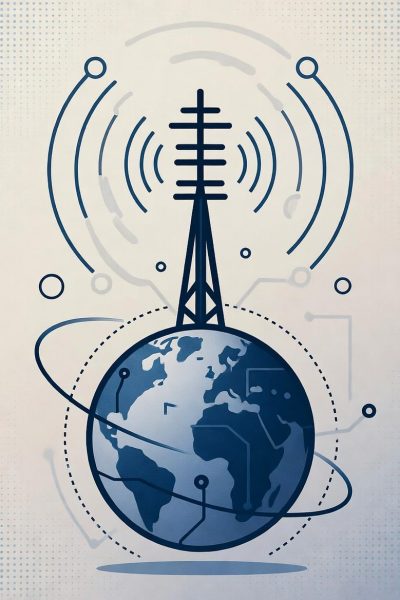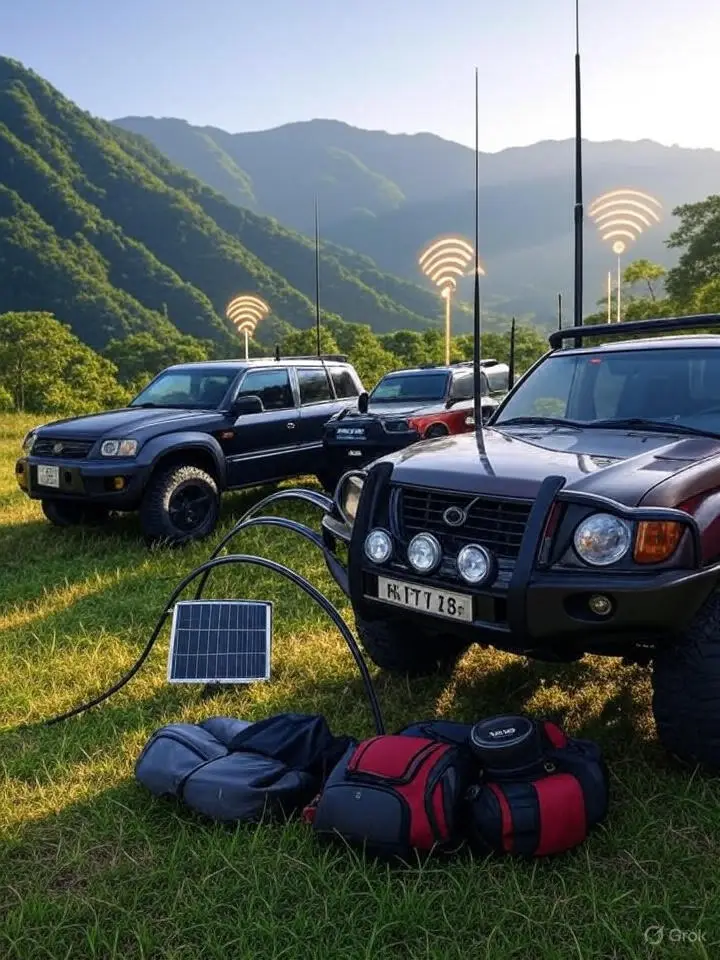The antenna is perhaps the most misunderstood component in any radio system, yet it’s arguably the most important. Whether you’re using amateur radio, GMRS, MURS, or CB, your antenna determines whether you’re communicating across town or barely across the street. Understanding basic antenna theory doesn’t require an engineering degree – just a willingness to see past the mystery and grasp a few fundamental concepts that govern how radio waves behave.
The Antenna’s Basic Job
Think of an antenna as a translator between two worlds. Inside your radio, electrical signals move through wires as electrons. Outside your radio, communication happens through electromagnetic waves traveling through space. The antenna’s job is to convert electrical energy into radio waves when transmitting, and convert radio waves back into electrical signals when receiving.
This conversion happens because of a fundamental principle: accelerating electrical charges create electromagnetic waves. When your radio pushes alternating current into an antenna, it causes electrons to accelerate back and forth. This acceleration launches electromagnetic waves into space, similar to how moving your hand up and down in water creates waves that spread outward.
The efficiency of this conversion depends on the relationship between the antenna’s physical size and the wavelength of the signal. This is why different radio services, operating on different frequencies, often use dramatically different antenna sizes.
Wavelength and Frequency: The Foundation
Radio waves are measured by their wavelength – the physical distance between wave peaks. Wavelength and frequency are inversely related: as frequency increases, wavelength decreases. This relationship is expressed in a simple formula: wavelength (in meters) equals 300 divided by frequency (in MHz).
For CB radio at 27 MHz, the wavelength is about 11 meters. For 2-meter amateur radio at 146 MHz, it’s about 2 meters. GMRS at 462 MHz has a wavelength around 65 centimeters, while MURS at 151 MHz is roughly 2 meters. These wavelengths directly influence optimal antenna sizes for each service.
The most efficient antenna length is related to these wavelengths. A half-wavelength antenna for CB would be about 17 feet long, while a quarter-wavelength antenna would be about 8.5 feet. This is why CB antennas are typically much longer than GMRS antennas – they’re working with much longer wavelengths.
Resonance: The Sweet Spot
Resonance is when an antenna naturally wants to vibrate at a particular frequency, like a tuning fork that rings at a specific note. A resonant antenna efficiently converts between electrical and electromagnetic energy with minimal waste. When an antenna is resonant at your operating frequency, more of your radio’s power becomes radio waves instead of heat.
Achieving resonance involves cutting an antenna to the right length for your frequency. This is why antenna manufacturers specify their products for particular frequency ranges. Using an antenna outside its designed range is like trying to play a violin with a bass bow – it might make some sound, but it won’t work well.
You can sometimes force a non-resonant antenna to work using an antenna tuner, which electrically adjusts the antenna system to appear resonant to the radio. However, this doesn’t change the actual antenna efficiency – it just prevents your radio from reducing power to protect itself.
SWR: The Health Check
Standing Wave Ratio (SWR) measures how well your antenna system is working. When everything is perfectly matched, all the power from your radio flows into the antenna and radiates away. When there’s a mismatch, some power reflects back toward the radio, creating standing waves in the feed line.
An SWR of 1:1 is perfect (but practically impossible). An SWR below 1.5:1 is excellent. Up to 2:1 is acceptable for most radios. Above 3:1, most modern radios start reducing power to protect themselves. High SWR doesn’t just waste power – it can damage your radio’s final amplifier.
Common causes of high SWR include incorrect antenna length, poor ground plane, damaged coax cable, or water infiltration in connectors. Checking SWR should be part of any antenna installation or troubleshooting process.
Antenna Types and Patterns
Different antenna designs serve different purposes. A vertical antenna, like a CB whip or GMRS rubber duck, radiates equally in all horizontal directions – ideal for mobile operation or when you don’t know where other stations are located. The trade-off is that vertical antennas send some energy upward at angles that don’t help with ground communication.
Directional antennas, like Yagi beams, concentrate energy in one direction. This provides gain (apparent power increase) in that direction while reducing signals from other directions. Great for fixed-location communication or weak-signal work, but impractical for mobile use.
Ground plane antennas, common for base stations, use radial elements to create an electrical mirror that helps the antenna radiate efficiently. Mobile antennas use the vehicle’s metal body as a ground plane, which is why magnetic mount antennas work better on metal roofs than on plastic surfaces.
Practical Considerations by Service
CB Radio (27 MHz): The long wavelength means even quarter-wave antennas are substantial. Base stations often use 18-foot vertical antennas for best performance. Mobile installations benefit from the longest antenna practical – the difference between a 4-foot and 8-foot antenna is dramatic.
Amateur Radio: With multiple bands available, many operators use multi-band antennas that compromise individual band performance for convenience. On 2 meters and 70 centimeters, even full-sized antennas are manageable. HF bands require creative solutions like wire dipoles or compact verticals with loading coils.
GMRS (462 MHz): The short wavelength allows efficient antennas in compact sizes. A 6-inch antenna can work reasonably well, though 15-inch models perform better. Base stations benefit from high-gain vertical antennas that can dramatically extend range.
MURS (151 MHz): Similar to 2-meter amateur radio, MURS works well with moderate-sized antennas. Vehicle antennas around 18 inches provide good performance. The VHF frequency provides better penetration through vegetation than UHF services like GMRS.
Height and Location Matter
Antenna height might be the single most important factor for communication range. Radio waves at VHF and UHF frequencies travel primarily by line-of-sight. Raising an antenna from ground level to 30 feet can double or triple your communication distance.
This is why repeater antennas are placed on towers, tall buildings, or mountain tops. It’s also why a handheld radio works better from a hilltop than from a valley. For base stations, getting your antenna above surrounding obstacles – trees, buildings, hills – dramatically improves performance.
Location also affects antenna pattern. Antennas near metal objects have their patterns distorted. Antennas inside buildings lose significant signal strength penetrating walls. Vehicle antennas placed at different locations (roof, trunk, mirror) exhibit different patterns and performance.
Feed Lines: The Critical Link
The coax cable connecting your radio to the antenna is more critical than many realize. Poor quality or damaged coax can negate the benefits of an excellent antenna. Loss in coax increases with frequency – what works for CB might be terrible for GMRS.
Use the shortest length of the best coax you can afford. RG-8X is a good compromise for most installations. RG-58 is acceptable for short runs at lower frequencies. LMR-400 or similar is ideal for long runs or UHF frequencies. Always weatherproof outdoor connections – water in coax destroys performance.
Making It Work
Understanding antenna theory helps you make intelligent decisions about your radio system. You’ll know why that expensive antenna might be worth the investment, why mounting location matters, and why your buddy’s setup works better than yours.
Remember that antennas are a system – the antenna itself, its mounting location, the feed line, and the connectors all affect performance. A modest antenna properly installed will outperform an expensive antenna poorly implemented.
The beauty of antenna theory is that it’s consistent across all radio services. Whether you’re working DX on amateur radio, coordinating a convoy on CB, communicating with family on GMRS, or managing a job site on MURS, the same principles apply. Master these basics, and you’ll maximize your communication capability regardless of which radio service you choose.
Affiliate Disclosure:
“Just so you know, some of the links on this page are affiliate links. This means if you decide to make a purchase through one of those links, I might earn a small commission at no extra cost to you. Your support helps keep this content going—thank you!”



